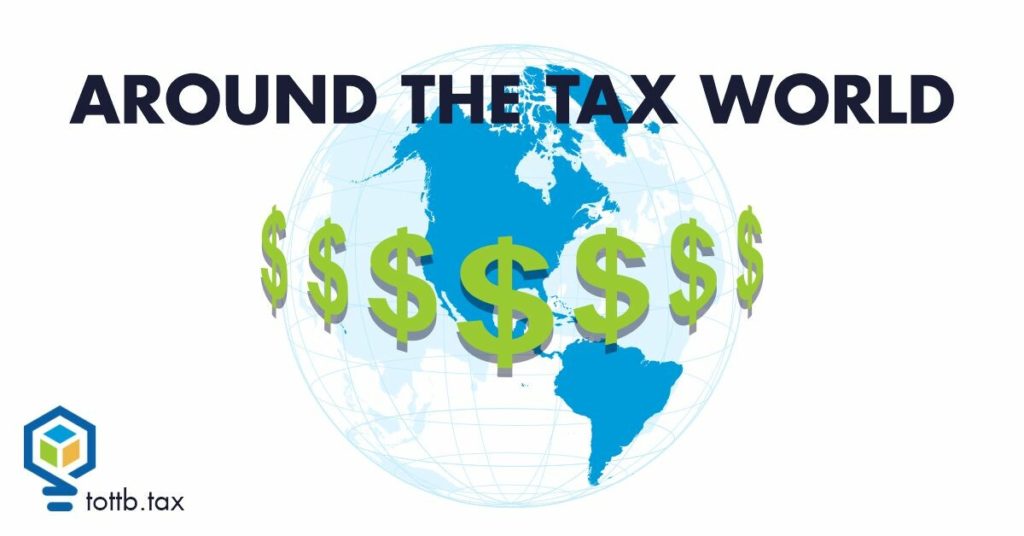
At Around the Tax World, you can find out all about what’s going on in the wonderful, worldwide world of tax. Every month, we’ll feature a few mini-articles on what’s been going on in the world when it comes to tax, and fully available for viewing even if you don’t have a subscription.
If you wish to subscribe and gain access to all articles on the site, be sure to check out the benefits of doing so here!
Check out what’s happening all around the world of tax!
In The Headlines
- Ryan Reynolds banks $1.35 billion after the sale of his latest business venture. Reynolds is a minority owner of Mint Mobile, which was recently purchased by T-Mobile. Lucky for the wireless provider, the actor will continue to be the face of the company. This isn’t Reynolds’ first business success—in 2020, an alcohol brand he co-owned, Aviation Gin, was also purchased for $610 million.
- Cruise lovers may foot a higher bill on their next trip to the Bahamas. If a new tax measure is approved, the head tax for cruisers departing Nassau or Freeport would jump from $18 to $25 per person. The bill also introduces a $5 tourism environment tax and a $2 tourism enhancement tax. These tax hikes would almost triple cruise industry revenue for the Bahamas.
- Real Housewives star Teresa Giudice continues to struggle to pay her tax bills. Even after settling a $17,000 tax lien this year, the reality TV star still reportedly owes around $500,000 to the IRS. Some of these unpaid taxes go back to 2014 and 2015. The Bravo channel personality and her ex-husband once spent time in prison for bankruptcy fraud and failure to pay taxes, among other charges.
What's New In The Tax World?
The Tax Wars Rage on: Higher Standard Deduction vs. Expanded Child Credit, Small Business Tax Breaks vs. Clean Energy Tax Cuts… Who Will Win?
The latest federal tax proposal will be yet another battle of Red vs. Blue. Just days after the bipartisan debt deal was passed, Republicans put forward a bundle of tax cuts. The proposal included deep tax cuts for businesses and an increase in the standard deduction for households. Pushback from Democrats was swift. These changes would be funded by eliminating $216 billion in tax breaks set up by the Biden administration to increase the development of electric vehicles and renewable energy.
These arguments will likely only ramp up as the 2024 election draws near. Who should receive tax cuts and why? Another major election-season question will be the fate of the 2017 Tax Cuts and Jobs Act. Many of these Trump-era measures will expire at the end of 2025 and cause tax bills to go up for most Americans. Should these tax breaks be extended? Should they be replaced with entirely new legislation? This is the core argument on the table…
Republicans have been advocating for immediate relief for taxpayers by raising the standard deduction by $2,000 (or $4,000 for families). They have also backed measures like lower effective rates and lowering the bar for small businesses to fully expense new equipment. Conservatives have argued that these measures encourage more job creation by giving money back to businesses.
Democrats have argued that it’s better to play the long game when it comes to tax breaks. Liberal lawmakers have focused instead on measures that benefit children and empower companies to invest in clean energy. An example is renewing the expanded child tax credit, which offered monthly payments of up to $300 per child, and contributed to an all-time low in the U.S. child poverty rate of 5.2%.
State-By-State Updates
- California’s “mansion tax” is resulting in a surplus of vacant luxury homes worth over $5 million each. The city of Los Angeles imposed Measure ULA earlier this year to provide funding to solve the homelessness crisis. The measure introduced an additional 4% in taxes for properties sold for over $5 million and 5.5% in taxes for properties sold for over $10 million. A recent estimate stated that there are currently 400 available luxury homes in Los Angeles.
- The Massachusetts Senate passed a $590 million tax relief package. This bill needs to be reconciled with a similar package approved by the House before being sent to the governor’s desk. Measures include increased tax breaks for renters, seniors, and parents, as well as estate tax relief and a higher earned income tax credit. Unlike the Senate’s package, the House is recommending a short-term capital gains tax cut that would bring the rate down from 12% to 5%.
- Montana has approved $899 million of income and property tax rebates. Taxpayers who lived in Montana for all of 2021 and who filed their 2020 and 2021 state tax returns on time are eligible for a $1,250 rebate. Additionally, homeowners are eligible for a $675 rebate per year for 2022 and 2023 property taxes on their principal residence. Income tax rebates will be automatic, but residents will have to apply for the property tax rebate through the state’s online TransAction Portal.
- Pennsylvania’s Property Tax/Rent Rebate program has been extended until December 31, 2023. The program benefits state residents aged 65 and older, widows and widowers aged 50 and older, and people with disabilities aged 18 and older. The maximum rebate for most is $650, but some homeowners may qualify for supplemental rebates that increase the total to $975. Eligible residents can apply at mypath.pa.gov.
Tax Planning Tips
How “stealth” taxes can impact retirees—and how to avoid them. 2023 introduced the highest cost-of-living adjustments (COLAs) the nation has seen in 40 years. This year’s COLA is 8.7%, up from 5.9% last year. The increase means that seniors will receive more Social Security benefits… but they will also be subject to higher taxes. The root cause is that income tax thresholds for Social Security recipients have not changed with inflation. As it stands, taxpayers with provisional income above $25,000 have up to 50% of their Social Security benefits taxed, and taxpayers with over $34,000 in provisional income have up to 85% taxed.
Financial experts often refer to these as “stealth” taxes, since many people are unprepared for their impact on retirement income. Additionally, in 11 states, seniors may also have to pay state taxes—including Colorado, Connecticut, Kansas, Minnesota, Missouri, Montana, Nebraska, New Mexico, Rhode Island, Utah and Vermont.
Strategies for reducing Social Security taxes are limited, but the most common advice is to convert your 401(k) or traditional IRA to a Roth IRA, since Roth IRA distributions do not count toward your provisional income. If possible, taxpayers should do the Roth conversion by age 63, since your Medicare premium will be calculated based on your income from the last two years and will be deducted from your Social Security check.
When can buying a used electric vehicle get you a $4,000 tax reduction? Under the Inflation Reduction Act, many used EVs may be eligible for a federal tax credit, but it’s often up to the consumer to do their research. Car dealerships may not know how the tax credits work, especially because taxpayers need to qualify personally and the car they purchase must meet specific qualifications.
Taxpayers can start by consulting the IRS’s list of qualifications. To receive the tax credit for a used EV, you must:
- Purchase the vehicle for use and not resale
- Not be the vehicle’s original owner
- Not be claimed as a dependent on someone else’s tax return
- Not have claimed another used clean vehicle credit within 3 years of the purchase date
- Earn no more than $75,000 in adjusted gross income (or $112,500 for heads of household and $150,000 for married taxpayers filing jointly)
Second, taxpayers should look through the official list of eligible used cars. Note that only used EVs and plug-in hybrids that cost less than $25,000 will qualify. Different states also offer their own incentives for purchasing a new or used EV.
NOT A MEMBER YET?

SUBSCRIBE TO GET ALL OF OUR
GREAT ARTICLES AND RESOURCES!
CURRENT EDITION

Intentionally Filing a Defective Tax Return
Creativity on a tax return is a natural tendency. Many strategies and behaviors we know are wrong, e.g. not reporting all income. However, is it ever okay to disregard some deductions and pay more tax? At first glance, it would seem that the IRS should like the idea of more reported income and a higher tax liability attached to the additional income. The IRS does not.

Side Hustles and Tax Tussles: Tax in the Gig and Share Economy Part Two
The gig economy involves more than one-off and part-time jobs. It also includes when you share your property in exchange for money. This can be a residential property, a vacation home, or even a vehicle. The gig economy has connected those who need rides and places to stay with owners via online platforms. We refer to this part of the gig economy as the share economy.
Accessing these accommodations is easy with the online platforms. But how the people participating should report their income isn’t quite as straightforward. Last time we looked at how your clients should report gig income, just like any other income made as a sole proprietor.
But making money from renting your property out is different, right? If you have clients with rental properties, you report their income on Schedule E (1040), Supplemental Income and Loss. We know from last time that we report gig economy income on Schedule C (1040), Profit or Loss from Business. So, how does rental income derived from the share economy get reported on a tax return? Every taxpayer’s favorite answer, it depends.

Loose Change in Your Couch and Maybe a Tax Break at Your Kitchen Table
A 2023 Tax Court decision upheld what many small business owners and tax practitioners have wondered about for some time. The court found that shareholders of an S corporation could exclude rental income paid to them by their S corporation for holding planning meetings in their homes. While the IRS and court found that the amounts charged by the shareholders were excessive, the court found the arrangement itself within the bounds of the law.
This article examines this case and underlying law and when and how this is a planning idea worth pursuing, the limitations and unknowns involved, and the policy implications of this long standing exclusion. The case is Sinopoli, TC Memo 2023-105 involving the exclusion at IRC Section 280A(g).
